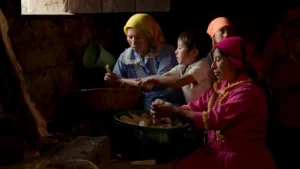The Ball Game – The Mayan Civilization
Return to the main article The Maya Civilization
The ballgame represents the origins of the universe and aims to reenact the myths of the creation of corn and other astronomical phenomena. It is a rite of initiation, death, and rebirth that legitimizes military action and political power.
The struggle (between players, celestial bodies, or the ball) can represent the encounter between the twins (from the Popol Vuh) and the gods of the underworld. This game had various variations depending on the time and place, but generally a rubber ball was used, which was struck with the waist, knees, shoulders, and elbows.
The objective of the game was to make the ball pass through a narrow ring placed on one of the walls of the playing field. Even today, it is practiced in Guatemala in its ritual form and in Mexico, either as a new form of tourist attraction or purely as a sport.
In other places where the ball courts lack scoring rings, it is believed that the winner was determined by the team or player who gained lines on the field, eventually cornering the opponent (similar to American football).
The number of players varied, and sometimes players used «rackets» or sticks. They protected their chest and head to avoid the strong impact of the ball. The game could last day and night, and there are no historical sources that mention human sacrifice or decapitation of the loser.
Some historians estimate that the player who lost their life was actually a prisoner of war, forced to play by the victors. This weakened, tired, and wounded prisoner of war would lose the game, be sacrificed, and become part of a fertility rite as they would go to paradise.
This game didn’t always end with human sacrifices, as bets were made and the loss was only what was wagered (according to Aztec historical sources). In some Maya fields in Guatemala and Honduras, the winning player would chase the spectators since, as a rule, they had the right to take away belongings they liked the most.
Return to the main article The Maya Civilization



